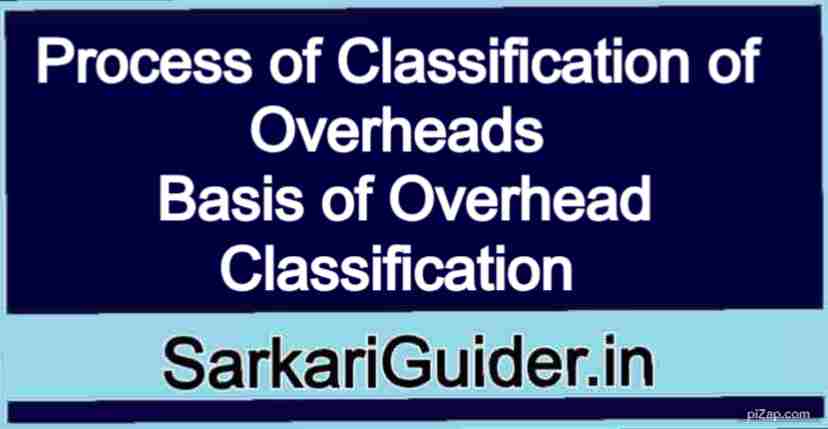
Classification of Overheads
The process of classification of overheads involves:
(a) The determination of the classes or groups in which the costs are sub-divided.
(b) The actual process of classification of the various items of expenses into one or another of the groups.
The number of overheads are too much and it is difficult to determine how much amount has been spent on particular item in the period.
Overheads are classified into a number of specified heads so that items of expenses of a similar nature may be grouped together under one head.
The process of classification of overheads endure depends upon die type and size of a business and the nature of the product or service rendered:
Generally overheads are classified on the following basis:
1. Nature or Element-wise Classification.
2. Function-wise Classification.
3. Normality-wise Classification.
4. Control-wise Classification
5. Variability or Behavior-wise Classification.
(1) Nature or Element-wise Classification
Based on its elements, overhead is classified in the following
(i) Indirect Materials.
(ii) Indirect Labour.
(iii) Indirect Expenses.
(2) Function-wise Classification
Overheads can be divided into the following categories on functional basis:
(i) Factory Overheads
(ii) Office and Administration Overheads
(iii) Selling Overheads
(vi) Distribution Overheads
(3) Normality-wise Classification
Based on its normality, overhead is classified in the following two categories:
(i) Normal overheads
It is the overhead at a given level of output in the condition at which that level of output is normally achieved. These overheads are included in the production cost of commodities.
(ii) Abnormal overhead
It refers to those overheads which are expected to be incurred in attaining given output For example, cost of abnormal idle time, fire, theft, breakdown of machine, strike or lock out, etc. Such costs are charged to costing profit & loss account, not included in cost.
(4) Control-wise Classification
It can be divided into two parts-
(i) Controllable overheads: If refers to those overheads which can be controlled by management action at the point of their incurrence. The variable costs fall under this category.
For example, cost of materials may be controlled by purchasing in economic lots, seasonal purchasing, etc.
(ii) Uncontrollable overheads: It refers to those overhead which cannot be controlled by management at the point of their incurrence. The fixed costs ate fall under this category because they are not influenced by managerial action.
(5) Variability or Behavior-wise Classification
Based on the variability patterns overheads can be classified into the following categories
(i) Fixed overheads
It refers to those expenses which remain fixed in total amount with increase or decrease in volume of output for a particular period of time, e.g., rent of building, salary of manager, insurance of assets, etc.
Fixed overhead costs remain the same from one period to another except when they are deliberately changed, e.g., increments granted to staff. The incidence of fixed overhead on unit cost decreases as production increases and vice-versa.
In a hypothetical organization no expenditure remains unchanged for all time. Therefore, it is true to state that “fixed overhead is fixed within specified limit relating to time and activity.”
इसे भी पढ़े…
- वित्तीय प्रणाली की अवधारणा | वित्तीय प्रणाली के प्रमुख अंग अथवा संघटक
- भारतीय मुद्रा बाजार या वित्तीय बाजार की विशेषताएँ बताइए।
- मुद्रा का अर्थ एवं परिभाषा | Meaning and Definitions of money in Hindi
- मानी गयी आयें कौन सी हैं? | DEEMED INCOMES IN HINDI
- मुद्रा के प्रमुख कार्य क्या-क्या हैं ?| Functions of Money in Hindi
- कर नियोजन का अर्थ, परिभाषा, प्रकार, आवश्यक तत्त्व या विशेषताएँ, उद्देश्य, आवश्यकता एवं महत्व
- कर अपवंचन का अर्थ, विशेषताएँ, परिणाम तथा रोकने के सुझाव
- कर मुक्त आय क्या हैं? | कर मुक्त आय का वर्गीकरण | Exempted incomes in Hindi
- राष्ट्रीय आय की परिभाषा | राष्ट्रीय आय के मापन या गणना की विधियां
- कर नियोजन का अर्थ, परिभाषा, प्रकार, आवश्यक तत्त्व या विशेषताएँ, उद्देश्य, आवश्यकता एवं महत्व
- कर अपवंचन का अर्थ, विशेषताएँ, परिणाम तथा रोकने के सुझाव
- कर बचाव एवं कर अपवंचन में अन्तर | Deference between Tax avoidance and Tax Evasion in Hindi
- कर मुक्त आय क्या हैं? | कर मुक्त आय का वर्गीकरण | Exempted incomes in Hindi
- राष्ट्रीय आय की परिभाषा | राष्ट्रीय आय के मापन या गणना की विधियां
- शैक्षिक आय का अर्थ और सार्वजनिक एवं निजी आय के स्त्रोत
- गैट का अर्थ | गैट के उद्देश्य | गैट के प्रावधान | GATT Full Form in Hindi
- आय का अर्थ | आय की विशेषताएँ | Meaning and Features of of Income in Hindi
- कृषि आय क्या है?, विशेषताएँ तथा प्रकार | अंशतः कृषि आय | गैर कृषि आय
- आयकर कौन चुकाता है? | आयकर की प्रमुख विशेषताएँ
- मौद्रिक नीति का अर्थ, परिभाषाएं, उद्देश्य, असफलतायें, मौद्रिक नीति एवं आर्थिक विकास
- भारत में काले धन या काले धन की समस्या का अर्थ, कारण, प्रभाव या दोष
- निजीकरण या निजी क्षेत्र का अर्थ, विशेषताएँ, उद्देश्य, महत्त्व, संरचना, दोष तथा समस्याएं
- औद्योगिक रुग्णता का अर्थ, लक्षण, दुष्परिणाम, कारण, तथा सुधार के उपाय
- राजकोषीय नीति का अर्थ, परिभाषाएं, उद्देश्य, उपकरण तथा विशेषताएँ
- भारत की 1991 की औद्योगिक नीति- मुख्य तत्व, समीक्षा तथा महत्त्व
- मुद्रास्फीति या मुद्रा प्रसार की परिभाषा, कारण, परिणाम या प्रभाव
- मुद्रा स्फीति के विभिन्न रूप | Various Types of Inflation in Hindi
- गरीबी का अर्थ एवं परिभाषाएँ | भारत में गरीबी या निर्धनता के कारण अथवा समस्या | गरीबी की समस्या को दूर करने के उपाय
- बेरोजगारी का अर्थ | बेरोजगारी की प्रकृति | बेरोजगारी के प्रकार एवं विस्तार






